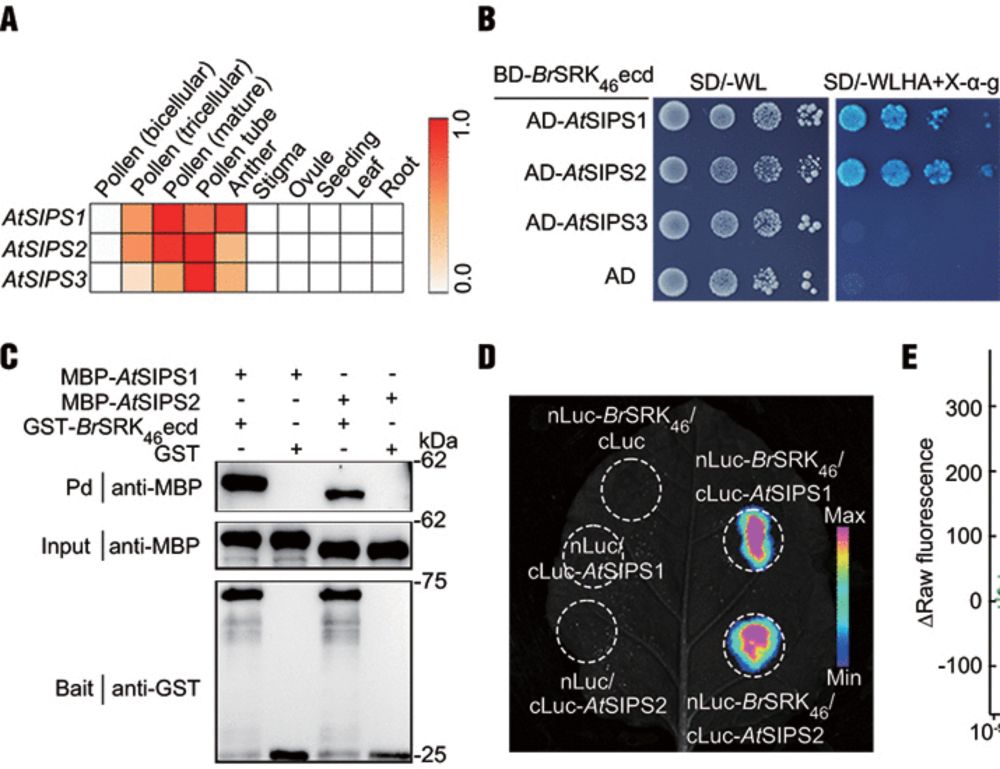

www.nature.com/nplants/volu...
This review uncovers the critical role of the plant cell wall in pest defence, integrating structural, molecular, and genetic insights to highlight its emerging significance in plant–pest interactions during herbivory - Perez-Alonso et al.
🔗 doi.org/10.1093/jxb/...
#PlantScience 🧪

This review uncovers the critical role of the plant cell wall in pest defence, integrating structural, molecular, and genetic insights to highlight its emerging significance in plant–pest interactions during herbivory - Perez-Alonso et al.
🔗 doi.org/10.1093/jxb/...
#PlantScience 🧪
A pollen ligand, SIPS, binds to the female receptor, SRK. SIPS binds to a conserved region of SRK, for interspecific incompatibility, unlike the self-incompatibility factor, which binds to a different, variable region
www.science.org/doi/10.1126/...
#PlantScience

A pollen ligand, SIPS, binds to the female receptor, SRK. SIPS binds to a conserved region of SRK, for interspecific incompatibility, unlike the self-incompatibility factor, which binds to a different, variable region
www.science.org/doi/10.1126/...
#PlantScience
This Review summarizes recent advances in large DNA fragment editing and discusses their applications and future prospects in precise breeding.

This Review summarizes recent advances in large DNA fragment editing and discusses their applications and future prospects in precise breeding.
Pesquet, Cesarino, Kajita & Pawlowski
👇
📖 nph.onlinelibrary.wiley.com/doi/10.1111/...
#LatestIssue

Pesquet, Cesarino, Kajita & Pawlowski
👇
📖 nph.onlinelibrary.wiley.com/doi/10.1111/...
#LatestIssue
www.nature.com/nplants/volu...

www.nature.com/nplants/volu...
The jack-o’-lantern, the carved pumpkin with the evil grin, has become the emblem of Halloween. This lantern has its historic roots in carved turnips, which have been used in folklore for hundreds of years.

The jack-o’-lantern, the carved pumpkin with the evil grin, has become the emblem of Halloween. This lantern has its historic roots in carved turnips, which have been used in folklore for hundreds of years.
Ac4c is an emerging RNA modification; regulates development and stress responses by modulating mRNA stability, translation and splicing.

Ac4c is an emerging RNA modification; regulates development and stress responses by modulating mRNA stability, translation and splicing.
A new synaptonemal complex protein; prevents clustering of crossovers during meiosis, so every pair of chromosomes receives at least one ‘obligate’ crossover.

A new synaptonemal complex protein; prevents clustering of crossovers during meiosis, so every pair of chromosomes receives at least one ‘obligate’ crossover.

... a source of diversity for the improvement of cultivated species through the concept of inter-crop translational research for breeding.

... a source of diversity for the improvement of cultivated species through the concept of inter-crop translational research for breeding.
LBD TFs in the cambium drive radial plant growth by regulating PECTATE LYASE-LIKE (PLL) enzymes that remodel cell wall pectin, promoting cell expansion.

LBD TFs in the cambium drive radial plant growth by regulating PECTATE LYASE-LIKE (PLL) enzymes that remodel cell wall pectin, promoting cell expansion.
SAIR1 forms phosphorylation-regulated condensates in guard cells, which link PAMP–MPK3/6 signalling to stomatal immunity.

SAIR1 forms phosphorylation-regulated condensates in guard cells, which link PAMP–MPK3/6 signalling to stomatal immunity.
"Here we show that the BSL1 phosphatase dephosphorylates CDKB1 to promote mitotic entry in Chlamydomonas."

"Here we show that the BSL1 phosphatase dephosphorylates CDKB1 to promote mitotic entry in Chlamydomonas."
... to generate a comprehensive structure of the multisubunit endocytic TPLATE complex.

... to generate a comprehensive structure of the multisubunit endocytic TPLATE complex.
- Bryophyte phenology: Shifting spore dispersal with climate change rdcu.be/eP4en
A highlight of "Rapid shifts in bryophyte phenology revealed by airborne eDNA" in @britishecologicalsociety.org :
doi.org/10.1111/1365...

- Bryophyte phenology: Shifting spore dispersal with climate change rdcu.be/eP4en
A highlight of "Rapid shifts in bryophyte phenology revealed by airborne eDNA" in @britishecologicalsociety.org :
doi.org/10.1111/1365...
lab.. when vascular cambial stem cells are lost, neighbouring xylem cells, divide to replace them Auxin transport drive this remarkable positioning of stem cells in vascular cambium during development and regeneration.
www.pnas.org/doi/abs/10.1...
lab.. when vascular cambial stem cells are lost, neighbouring xylem cells, divide to replace them Auxin transport drive this remarkable positioning of stem cells in vascular cambium during development and regeneration.
www.pnas.org/doi/abs/10.1...
#Arabidopsis #plantsci
www.nature.com/articles/s41...

#Arabidopsis #plantsci
www.nature.com/articles/s41...
- "Plant immunity: Engineering RLP receptors from the C side" rdcu.be/ePaS1
A brief highlight of this Article in @natbiotech.nature.com :
"Engineered pattern recognition receptors enhance broad-spectrum plant resistance" about swapping C-term domains rdcu.be/ePaTW

- "Plant immunity: Engineering RLP receptors from the C side" rdcu.be/ePaS1
A brief highlight of this Article in @natbiotech.nature.com :
"Engineered pattern recognition receptors enhance broad-spectrum plant resistance" about swapping C-term domains rdcu.be/ePaTW
Grassland degradation reduces ecosystem functionality while promoting soil biodiversity, highlighting its role in sustaining degraded grasslands.

Grassland degradation reduces ecosystem functionality while promoting soil biodiversity, highlighting its role in sustaining degraded grasslands.
GWAS identifies CDCA7 as a regulator of DNA methylation in Arabidopsis thaliana . CDCA7 binds the chromatin remodeller DDM1 and modulates the control of CG methylation.

GWAS identifies CDCA7 as a regulator of DNA methylation in Arabidopsis thaliana . CDCA7 binds the chromatin remodeller DDM1 and modulates the control of CG methylation.


"For practical outdoor illumination competitive with conventional lighting, this efficiency would need to reach 0.3% of the plant's metabolic energy budget, an improvement of nearly two orders of magnitude."
A #ResearchReview by Yu et al.
👇
📖 nph.onlinelibrary.wiley.com/doi/10.1111/...
#LatestIssue

"For practical outdoor illumination competitive with conventional lighting, this efficiency would need to reach 0.3% of the plant's metabolic energy budget, an improvement of nearly two orders of magnitude."
My summary here: www.science.org/doi/10.1126/...
Paper here:
doi.org/10.1073/pnas...

My summary here: www.science.org/doi/10.1126/...
Paper here:
doi.org/10.1073/pnas...
Featuring research on 🧪
🦆Threats to migratory shorebirds
🌍Phosphorus constraints on global photosynthesis
🦠Evolution of the meerkat MHC
Cover shows a larva of an emperor moth, from Li et al. www.nature.com/articles/s41...

Featuring research on 🧪
🦆Threats to migratory shorebirds
🌍Phosphorus constraints on global photosynthesis
🦠Evolution of the meerkat MHC
Cover shows a larva of an emperor moth, from Li et al. www.nature.com/articles/s41...

